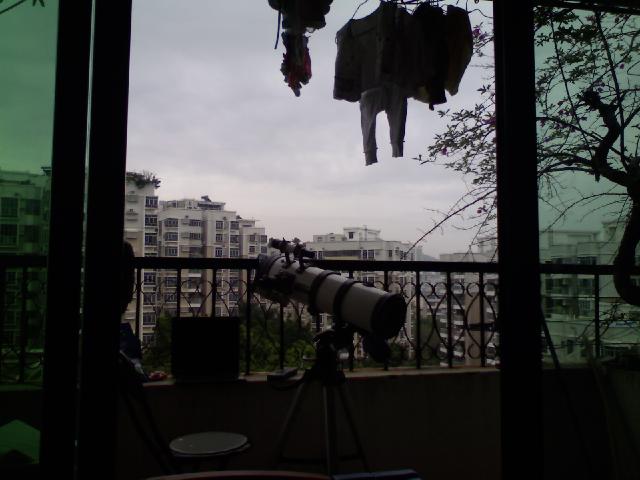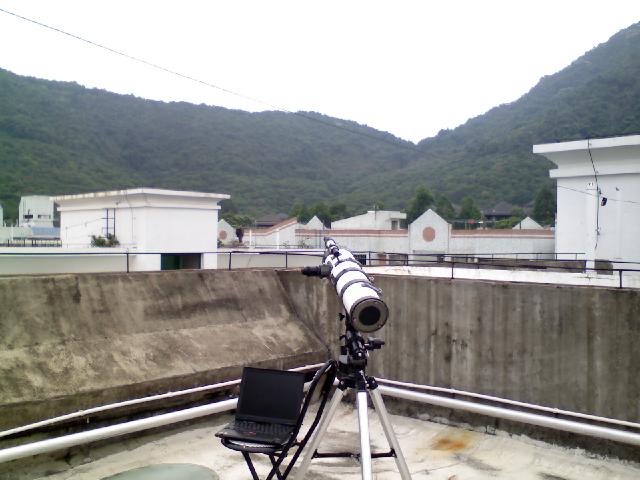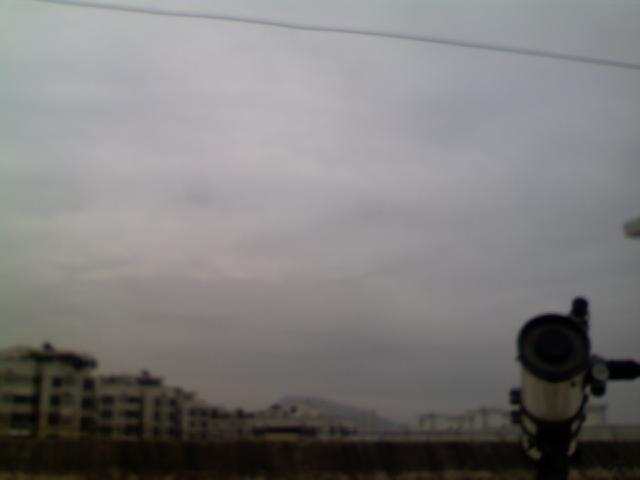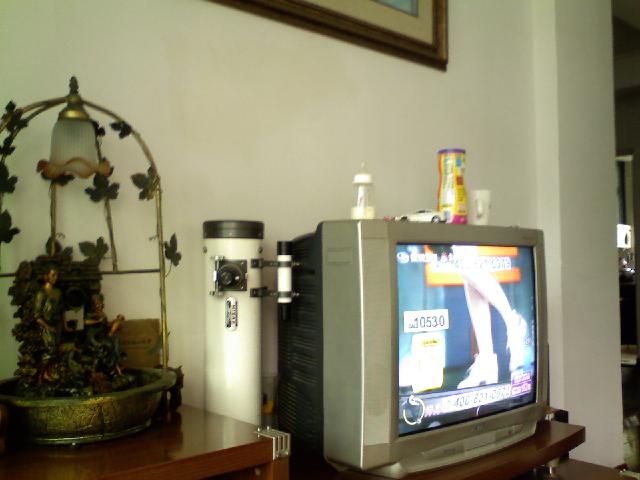MANDII
   

|
分享:



 ▲
▼
▲
▼




日本MIZAR望远镜最近也搬来深圳用,没为了别的,就为了找找星,喜欢找星。说起来我为什么会那么喜欢找星,这个也不太知道。可能和读中学一年级自然科学时第一次在实验室接触显微镜有关吧,香港初中一年级就开始有进入实验室,当时我有一段时间下课便走到图书馆里看一些这方面的书,微观生物的世界令我印象深刻。而现在利用望远镜,恰恰相反看的是宏观世界,遥远广阔的宁宙,目镜里看似平凡的东西,欲又不平凡。本是两回事,却又是同一回事,就是在那里找自已想找的东西。。。 把其中一部望远镜搬来深圳早在去年年中就有这个打算了,一直没真的去做,现在终于搬过来了,因为有时候我一家大小也在这边的。我会在阳台看,阳台能看东和南方的天空,或且有时会上楼顶看,楼顶的北极星幸好未被山挡住,我就住在顶层。 深圳是个年轻活泼的城市,年轻人多,我住的这个房子今年也有十一个年头了,深圳这个地方有着许多许多我的回亿 ,曾经走过的街角,有美好的回亿,也有伤感的回亿。我爱香港,也喜欢深圳。回想起,当年真没想到许多年后的今天,竟然会在这个土地上看起星来了。。。 MANDII 11年五一假期     
|
|
 x0 x0
 [31 楼]
From:新加坡 | Posted:2011-05-03 11:35 |
[31 楼]
From:新加坡 | Posted:2011-05-03 11:35 |
|
|
MANDII
   

|
分享:



 ▲
▼
▲
▼




CLOUDY NIGHTS / US ASTRONOMY
The maunal Goto methodology using object's TIME-ANGLE to find a deep sky object and take a picture of it .
Objective :
- It'a a fixed point observation ( visual and photography in a observatory )
With a low costing mount (EQ3) that do not have the GOTO function ,
- Manually search the deep sky objects in telescope , by using the object's time-angle at the time of observation ,
and turns the RA and DEC circle from the mount , to find out the objects in an eyepiece ,
- And take a picture of the object , note it down in a observation report .
Night Sky condition : In bewteen Urban and village place , not so many clear nights (without the clouds ) in a year , visual magnitude around 4.0-5.0 in clear nights .
Equipment cost : Telescope : Orion 6"/F5 Newtonian ( 2nd hand at price 1500HKD) that comes with several eyepices
Mount : EQ3 with one RA motor .( 2nd hand at price 300 HKD)
The height adjustable Pier ( self made at price 350 HKD)
Camera : DSI-I ( 2nd hand at price 800 HKD)
Total : 2950 HKD
Observing time : most of the time the obeservation taken place from 9:00p.m - 12:00p.m 3 hours of time ,
Within 3 hours time ,need to complete the whole observation in finding the objects and taking down it's image .
Steps :
0. The mount( EQ3) is Polar aligned well . This can be setup One time in ordinary day instead of observing night .
The alignment accuracy and requirement should be reached to the level that , the stars roundness under 2 min exposure in a single frame image , is accepted by your own . The better the mount is aligned , the better( more round ) the stars in a picture , and the more accuracy in finding out the objects by using it's time-angle value . In my case , I had to use drifting method since the polar star cannot be seen inside the obervatory polar scope .
1. At observing night , initialize the mount's RA calibration such that it can synchronise the stars moving position . Meanning that when you rotate the mount's RA axis to a certain value of a Time angle , the telescope should be pointed to the object that is located at the same time angle . Stars or DSO moving from east to west starting at time angle RA 18h00m00s up to 6h00m00s . 18 hour at eastern ground , 19 hour ...24 hour( at the top of the sky ) , 1 hour ,2 hour and so on ... upto 6 hour it reach the western ground . So totally 12 hours of time it moves the whole night sky . The DEC value of the object should be always fixed in reagrdness to differnt observing time . And the object can be seen in a eyepiece directly under the FOV of around 2 degree in an eyepiece . The minumin unit of the mount in RA circle is 10min , DEC circle is 2 degree . Thus , the FOV in an eyepeice should be setup samly to the FOV of the minimun unit( 10min and 2 degree).
The initialize process is :
a. check the target DSO object is located at the eastern or western sky hemisphere at the time of observation .
This can be easily known from the star chat in a computer .
b. If the target object is located at the Eastern hemisphere , point the telescope to the East horizontal level( approximate is OK ) , and then turns the RA circle to value 18h00m00s . After that , find a bright star in eastern sky , and point the telescope to it such that it is located in centre of an eyepice , then check it's time angle( e.g 21h10m00s) from the star chat at that moment of time . And turns the RA circle to it's time angle(21h10m00s) accordingly . After this step ,the bright star should be setup it's time angle in a mount . The RA axis becomes life . It looks like a real clock of the star moving time . Let say after 1 hour of time , even the motor of the mount is not switched on , even the star moves to a certain position of a new time angle , you just check the new time angle of the bright star from the star chat , and you can turns to the new value of RA circle to point directly to this bright star . The DEC value is just fixed no matter the star moves . Such DEC value of a star can also be known from the star chat . So we can point directly to a star by turning these two value of RA( time angle) and DEC of a star . The westren hemisphere initialization is same , but just at first point the telescope to the westren horizontal level first . And set a bright star at western side instead of eastern side . The other procedures are just same .
2. After the mount is initialized as a real clock of actual stars .
We can use the mount to find any of the objects now .
Each object should have a time angle and DEC value at the time of observing .
The bright stars do have , the DSO also have this two values .
Even the planets , and the moon is also have this two values .
Let say in more simpily , I just turn the time angle and DEC value of the mount , after that the moon can be seen in a eyepeice directly . I don't need to find it manually in a telescope . Samely , the Jupiter , the Mars and the DSO is found in same way .
These two values of time angle and DEC , can be known from the star chat in a computer , for any of astronomical objects .
What we need to do first , is just to initialize the mount to a real CLOCK of star moving .
3. After the object is seen in an eyepiece , I just insert the DSI to the eyepice holder , and starts the imaging process .
Most of the time I use less than 2 min of single frame exposure . And takes around 10 to 20 frames to do stacking and post imaging process . Finally , the DSO picture is got .
THE ABOVE IS SO CALLED " MANUAL GOTO/MANUALLY FIND A STAR BY USING IT"S TIME ANGLE "
I attach several picture samples that was taken by me in past times , using this manual star searching method .
MANDII
2011/07/22
|
|
 x0 x0
 [35 楼]
From:新加坡 | Posted:2011-07-22 12:22 |
[35 楼]
From:新加坡 | Posted:2011-07-22 12:22 |
|
|
MANDII
   

|
分享:



 ▲
▼
▲
▼




Cloudy Nights/ US ASTRONOMY
I need to revise some of the point in the above .
Firstly , In case it's used in western hemisphere , the RA circle is initially set to 6 hour compared to the 18 hour Eastern case . And also, this kind of initial setup to synchronise the time of the moving star , is a one time setup that can be used throughout the continuous several nights . No need to do the same setup evry night . Because stars position at same timming in two continues night , is bascily same under the FOV of the telescope in 2 degree .
2ndly , The stars and DSO is fixed the DEC value all the time . The Moon and planets changes this DEC value as the observing time varies . Basicly this mimute and next minute , is differently and obviously seen under a big magnification in the telescope .
Visual position( time angle and DEC ) always changes with time tremendously ,under magnification .
The Sun may also changes DEC value . I am not sure about the Sun as I haven't observed it previously .
However , even they change DEC , it can be easily got this value from the star chat , in any of the observing time .
If you turns the mount's two axis( Time angle and DEC ) , to point the telescope to the SUN and take a picture of it in camera .
Such approch do not need to use your naked eye to find a SUN in a telescope , and even throughout the whole imaging procedure .
Meaning that : Avoid the risk of our naked eye to be hurted by the SUN , by using this a cheap and practical way of so called "Human GOTO" methodology .
|
|
 x0 x0
 [36 楼]
From:新加坡 | Posted:2011-07-25 17:55 |
[36 楼]
From:新加坡 | Posted:2011-07-25 17:55 |
|
|
MANDII
   

|
分享:



 ▲
▼
▲
▼




Thanks you remind me this M93 . Yes I have to agree , it's nearly a 5 months time I haven't got even ONE picture of the deep sky ,since last time I did say to get the M93 on end of Feburury . Frankly speaking , it's very difficult to get a picture of DSO . For me , the main challenge is not any other thing , main difficulty is to keep on myself not to become a lazy man throughout the long waiting time of a clear nights . In Hong Kong , basicly every night is cloudy nights . You are getting disappointed during the waiting time . And you are not sure which day a clear night suddenly come . And you have to move your body right away without hesitation ,when such a clear night comes . And that is the real diffculty for me to move my body once again while I have been waiting too long .
But I will keep on doing it , too much excuse is no use , I will keep on to take as much deep sky picture as I can , by using the current equipment in my comming years of time . I insist to say without too much changes starting from the very beginning( 1 or 2 years ago) in using my equipments , the telescope , the mount and the camera ,though they are a very cheap equipments , but I believe they are just situable in my actual situation . They are the real good tools that can help me take Deep sky pictures .
I believe the time can solve this kind of difficluty as well .
|
|
 x0 x0
 [37 楼]
From:新加坡 | Posted:2011-07-26 10:26 |
[37 楼]
From:新加坡 | Posted:2011-07-26 10:26 |
|
|
|












